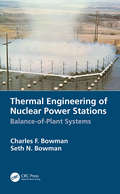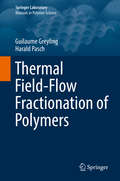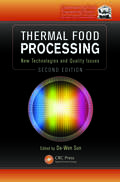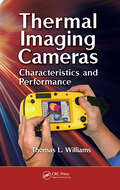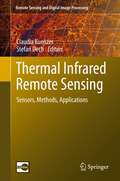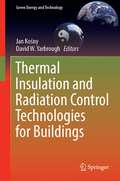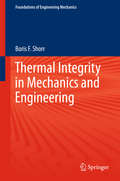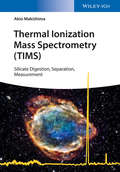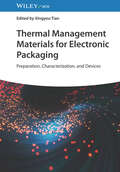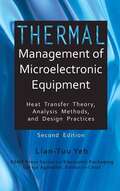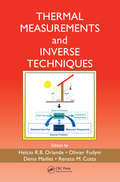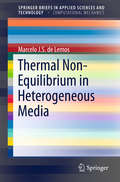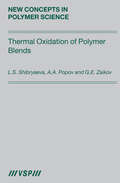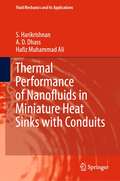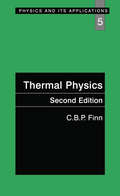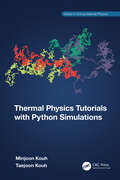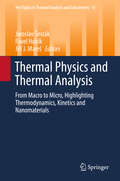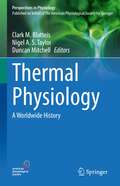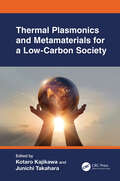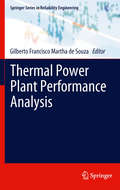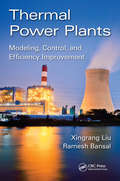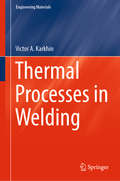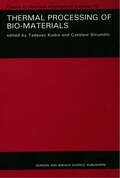- Table View
- List View
Thermal Engineering of Nuclear Power Stations: Balance-of-Plant Systems
by Charles F. Bowman Seth N. BowmanThermal Engineering of Nuclear Power Stations: Balance-of-Plant Systems serves as a ready reference to better analyze common engineering challenges in the areas of turbine cycle analysis, thermodynamics, and heat transfer. The scope of the book is broad and comprehensive, encompassing the mechanical aspects of the entire nuclear station balance of plant from the source of the motive steam to the discharge and/or utilization of waste heat and beyond. Written for engineers in the fields of nuclear plant and thermal engineering, the book examines the daily, practical problems encountered by mechanical design, system, and maintenance engineers. It provides clear examples and solutions drawn from numerous case studies in actual, operating nuclear stations.
Thermal Field-Flow Fractionation of Polymers (Springer Laboratory)
by Harald Pasch Guilaume GreylingThis book introduces the reader to thermal field-flow fractionation and discusses its advantages over the fundamental problems associated with traditional column-based analytical techniques commonly used to characterize polymers and macromolecules. The authors discuss the theoretical background, equipment, experimental procedures as well as the recent advances and applications of thermal field-flow fractionation. Complete with several practical examples and troubleshooting guidelines, the book is written for beginners and experienced separation scientists alike and will enable its readers to optimize their experimental conditions for their specific separation needs and problems.
Thermal Food Processing: New Technologies and Quality Issues, Second Edition (Contemporary Food Engineering)
by Da-Wen SunThermal processing remains one of the most important processes in the food industry. Now in its second edition, Thermal Food Processing: New Technologies and Quality Issues continues to explore the latest developments in the field. Assembling the work of a worldwide panel of experts, this volume highlights topics vital to the food industry today an
Thermal Imaging Cameras: Characteristics and Performance
by Thomas WilliamsThe ability to see through smoke and mist and the ability to use the variances in temperature to differentiate between targets and their backgrounds are invaluable in military applications and have become major motivators for the further development of thermal imagers. As the potential of thermal imaging is more clearly understood and the cost decr
Thermal Infrared Remote Sensing
by Claudia Kuenzer Stefan DechThis book provides a comprehensive overview of the state of the art in the field of thermal infrared remote sensing. Temperature is one of the most important physical environmental variables monitored by earth observing remote sensing systems. Temperature ranges define the boundaries of habitats on our planet. Thermal hazards endanger our resources and well-being. In this book renowned international experts have contributed chapters on currently available thermal sensors as well as innovative plans for future missions. Further chapters discuss the underlying physics and image processing techniques for analyzing thermal data. Ground-breaking chapters on applications present a wide variety of case studies leading to a deepened understanding of land and sea surface temperature dynamics, urban heat island effects, forest fires, volcanic eruption precursors, underground coal fires, geothermal systems, soil moisture variability, and temperature-based mineral discrimination. 'Thermal Infrared Remote Sensing: Sensors, Methods, Applications' is unique because of the large field it spans, the potentials it reveals, and the detail it provides. This book is an indispensable volume for scientists, lecturers, and decision makers interested in thermal infrared technology, methods, and applications.
Thermal Insulation and Radiation Control Technologies for Buildings (Green Energy and Technology)
by Jan Kośny David W. YarbroughThis book offers a unique treatment of building insulating products and the integration of these products with building components. This book was written for all those involved in building design, specification, construction, and commissioning, providing them with an understanding of and appreciation for the wide variety of thermal insulation products and technologies available for use in all types of buildings. The book proceeds from basic definitions and discussion of heat-transfer topics and thermal insulation concepts, to the design and use of these products. The impact of thermal insulation on dynamic building performance, including factors other than heating and cooling, is also discussed.The book does not require an advanced mathematical background. The authors provide sufficient information to provide a qualitative understanding, with more mathematical sections included for those interested in modeling and analysis. The basic physics associated with heat transfer in buildings are presented, along with the steady-state and transient analysis techniques needed for the effective implementation of thermal insulation and assemblies.Modern building design involves the integration of comfort, safety, economics, durability and cost considerations, all of which impact the selection and use of thermal insulation materials in buildings. In addition to theoretical explanations of the underlying science, the book details the properties and application of new thermal insulation materials, including vacuum panels, gas-filled panels, aerogels, phase-change materials, and radiation control technologies.Given its scope, the book will be of interest to researchers and building engineers wishing to understand the latest technologies and materials available, so as to achieve reduced energy consumption in commercial and residential buildings.
Thermal Integrity in Mechanics and Engineering
by Boris F. ShorrThe book is targeted at engineers, university lecturers, postgraduates, and final year undergraduate students involved in computational modelling and experimental and theoretical analysis of the high-temperature behavior of engineering structures. It will also be of interest to researchers developing the thermal strength theory as a branch of continuum mechanics. Thermal integrity is a multidisciplinary field combining the expertise of mechanical engineers, material scientists and applied mathematicians, each approaching the problem from their specific viewpoint. This monograph draws on the research of a broad scientific community including the author's contribution. The scope of thermal strength analysis was considerably extended thanks to modern computers and the implementation of FEM codes. However, the author believes that some material models adopted in the advanced high-performance software, are not sufficiently justificated due to lack of easy-to-follow books on the theoretical and experimental aspects of thermal integrity. The author endeavors to provide a thorough yet sufficiently simple presentation of the underlying concepts, making the book compelling to a wide audience.
Thermal Ionization Mass Spectrometry (TIMS)
by Akio MakishimaThis first book to discuss both separation chemistry and mass spectrometry for mineral and rock analysis compares the two frequently used techniques, analyzing both their scope and limitations by way of numerous practical examples. The excellent and highly experienced author adopts a comprehensive and systematic approach, reviewing all the steps involved in an analytical workflow. In addition to thermal ionization mass spectrometry (TIMS), he also discusses applications of ICP-MS. Furthermore, alongside detailed protocols on sample preparation and mass spectrometric measurements, numerous practical hints are given. A must-have handy guide for all isotope geochemists and anyone involved in isotope analysis.
Thermal Management Materials for Electronic Packaging: Preparation, Characterization, and Devices
by Xingyou TianThermal Management Materials for Electronic Packaging Practical resource exploring the theoretical and experimental basis as well as solutions for the development of new thermal management materials for electronic packaging Thermal Management Materials for Electronic Packaging: Preparation, Characterization, and Devices provides in-depth and systematic summaries on cutting-edge thermal management materials for high-power density electronic devices, introducing the preparation methods and application scenarios of thermal management materials for electronic packing, covering refinements of thermal conductivity theory and performance prediction models for multiphase composites, and overall focusing on key scientific issues related to the subject, such as the internal interface of new high thermal conductive substrate materials and the mechanism of spatial topology on performance. The text also discusses key issues on the design and preparation of thermal conductive substrate materials with high thermal conductive properties, including their characterization, properties, and manipulation, as well as the latest methods, techniques, and applications in this rapidly developing area. Sample topics covered in Thermal Management Materials for Electronic Packaging include: Basic concepts and laws of thermal conduction, heat conduction differential equation and finite solution, and thermal conductivity of solids Definition and classification of electronic packaging, thermal management in electronic equipment, and requirements of electronic packaging materials Synthesis and surface modification of high thermal conductive filler and the synthesis of substrates and preparation of thermal conductive composites with inorganic ceramic skeleton structure Assembly of thermal conductive materials in different dimensions and preparation of composite materials, and reliability analysis and environmental performance evaluation Thermal Management Materials for Electronic Packaging serves as an ideal reference for researchers and workers in related fields to significantly improve the mechanical and thermal management properties of materials, expand the material selection and design margin of substrates, and develop substrates that meet the application needs of different gradients.
Thermal Management of Microelectronic Equipment: Heat Transfer Theory, Analysis Methods, and Design Practices (Electronic Packaging)
by Lian-Tuu Yeh D. AgonaferThis Second Edition of a classic text is fully updated and greatly expanded, with in-depth revisions that include advancements in the component technology of microelectronics. The most noticeable one is the addition of an entirely new chapter on microwave modules and the gallium arsenide (GaAs) chips, which have seldom been discussed in any of the textbooks or publications in the area of thermal management of electronic equipment. With this new chapter, the book is complete and whole in the area of thermal design of electronics systems. <p><p>With an increased demand on system reliability and performance combined with the miniaturization of devices, thermal consideration has become a crucial factor in the design of electronic packaging, from chip to system levels. This book emphasizes the solving of practical design problems in a wide range of subjects related to various heat transfer technologies. While focusing on understanding the physics involved in the subject area, the authors have provided substantial practical design data and empirical correlations used in the analysis and design of equipment. The book provides the fundamentals along with a step-by-step analysis approach to engineering, making it an indispensable reference volume.
Thermal Measurements and Inverse Techniques (Heat Transfer)
by Renato M. Cotta Helcio R.B. Orlande Olivier Fudym Denis MailletWith its uncommon presentation of instructional material regarding mathematical modeling, measurements, and solution of inverse problems, Thermal Measurements and Inverse Techniques is a one-stop reference for those dealing with various aspects of heat transfer. Progress in mathematical modeling of complex industrial and environmental systems has e
Thermal Non-Equilibrium in Heterogeneous Media
by Marcelo J.S. de LemosThis book presents, in a self-contained fashion, a series of studies on flow and heat transfer in porous media, in which distinct energy balances are considered for the porous matrix and for the permeating fluid. Detailed mathematical modeling is presented considering both volume and time averaging operators simultaneously applied to the governing equations. System involving combustion in the gaseous phase, moving bed and double-diffusion mechanism are analyzed. Numerical results are presented for each case. In the end, this book contains the description of a tool that might benefit engineers in developing and designing more efficient thermal equipment.
Thermal Oxidation of Polymer Blends: The Role of Structure
by Gennady Zaikov Lyudmila Shibryaeva Anatoly PopovTo identify the specific features of the kinetics of oxidation of polymer mixtures, determine the key structural elements, and create a model that can describe the mechanism of thermal oxidation of polymer mixtures, it is necessary to determine the relation between the initial structure of a polymer mixture, structural rearrangements associated wit
Thermal Performance of Nanofluids in Miniature Heat Sinks with Conduits (Fluid Mechanics and Its Applications #131)
by Hafiz Muhammad Ali S. Harikrishnan A. D. DhassThis comprehensive book focuses on the basic physical features and purpose of nanofluids and miniature heat sinks. The contents demonstrate the design modification, fabrication, experimental investigation, and various applications of miniature heat sinks. The book provides context for thermal performance of miniature heat sinks as well as summaries of experimental results correlations that reflect the current technical innovations are included. This book is a useful reference for both academia and industry alike.
Thermal Physics
by C.B.P. FinnConcise yet thorough, accessible, authoritative, and affordable. These are the hallmarks of books in the remarkable Physics and its Applications series. Thermodynamics is an essential part of any physical sciences education, but it is so full of pitfalls and subtleties, that many students fail to appreciate its elegance and power. In Thermal Physics, the author emphasizes understanding the basic ideas and shows how the important thermodynamics results can be simply obtained from the fundamental relations without getting lost in a maze of partial differentials. In this second edition, Dr. Finn incorporated new sections on scales of temperature, availability, the degradation of energy, and lattice defects. The text contains ample illustrations and examples of applications of thermodynamics in physics, engineering, and chemistry.
Thermal Physics
by David GoodsteinWritten by distinguished physics educator David Goodstein, this fresh introduction to thermodynamics, statistical mechanics, and the study of matter is ideal for undergraduate courses. The textbook looks at the behavior of thermodynamic variables and examines partial derivatives - the essential language of thermodynamics. It also explores states of matter and the phase transitions between them, the ideal gas equation, and the behavior of the atmosphere. The origin and meaning of the laws of thermodynamics are then discussed, together with Carnot engines and refrigerators, and the notion of reversibility. Later chapters cover the partition function, the density of states, and energy functions, as well as more advanced topics such as the interactions between particles and equations for the states of gases of varying densities. Favoring intuitive and qualitative descriptions over exhaustive mathematical derivations, the textbook uses numerous problems and worked examples to help readers get to grips with the subject.
Thermal Physics
by Ralph BaierleinSuitable for both undergraduates and graduates, this textbook provides an up-to-date, accessible introduction to thermal physics. The material provides a comprehensive understanding of thermodynamics, statistical mechanics, and kinetic theory, and has been extensively tested in the classroom by the author who is an experienced teacher. This book begins with a clear review of fundamental ideas and goes on to construct a conceptual foundation of four linked elements: entropy and the Second Law, the canonical probability distribution, the partition function, and the chemical potential. This foundation is used throughout the book to help explain new topics and exciting recent developments such as Bose-Einstein condensation and critical phenomena. The highlighting of key equations, summaries of essential ideas, and an extensive set of problems of varying degrees of difficulty will allow readers to fully grasp both the basic and current aspects of the subject. A solutions manual is available for instructors. This book is an invaluable textbook for students in physics and astronomy.
Thermal Physics Tutorials with Python Simulations (Series in Computational Physics)
by Minjoon Kouh Taejoon KouhThis book provides an accessible introduction to thermal physics with computational approaches that complement the traditional mathematical treatments of classical thermodynamics and statistical mechanics. It guides readers through visualizations and simulations in the Python programming language, helping them to develop their own technical computing skills (including numerical and symbolic calculations, optimizations, recursive operations, and visualizations). Python is a highly readable and practical programming language, making this book appropriate for students without extensive programming experience. This book may serve as a thermal physics textbook for a semester-long undergraduate thermal physics course or may be used as a tutorial on scientific computing with focused examples from thermal physics. This book will also appeal to engineering students studying intermediate-level thermodynamics as well as computer science students looking to understand how to apply their computer programming skills to science. Key features Major concepts in thermal physics are introduced cohesively through computational and mathematical treatments. Computational examples in Python programming language guide students on how to simulate and visualize thermodynamic principles and processes for themselves.
Thermal Physics and Thermal Analysis: From Macro to Micro, Highlighting Thermodynamics, Kinetics and Nanomaterials (Hot Topics in Thermal Analysis and Calorimetry #11)
by Jaroslav Šesták Jiří J. Mareš Pavel HubíkFeatures twenty-five chapter contributions from an international array of distinguished academics based in Asia, Eastern and Western Europe, Russia, and the USA. This multi-author contributed volume provides an up-to-date and authoritative overview of cutting-edge themes involving the thermal analysis, applied solid-state physics, micro- and nano-crystallinity of selected solids and their macro- and microscopic thermal properties. Distinctive chapters featured in the book include, among others, calorimetry time scales from days to microseconds, glass transition phenomena, kinetics of non-isothermal processes, thermal inertia and temperature gradients, thermodynamics of nanomaterials, self-organization, significance of temperature and entropy. Advanced undergraduates, postgraduates and researchers working in the field of thermal analysis, thermophysical measurements and calorimetry will find this contributed volume invaluable. This is the third volume of the triptych volumes on thermal behaviour of materials; the previous two receiving thousand of downloads guaranteeing their worldwide impact.
Thermal Physiology: A Worldwide History (Perspectives in Physiology)
by Duncan Mitchell Clark M. Blatteis Nigel A. S. TaylorThis edited volume records the critical historical developments in thermal physiology and makes them accessible to new and senior thermal biologists and scientists in related fields. Readers will discover how the discipline developed all over the world. Contributions from 14 different countries recollect all prominent discoveries, starting in the 18th century. Like other volumes of the Perspectives in Physiology series, this book reveals the people behind these discoveries. The authors also set the scenes in which the research was conducted in their countries. From geopolitical frameworks to new technologies and extraordinary personalities - this volume shows that scientific progress is influenced by many, often unforeseeable, factors. The history of thermal physiology not only is a story about individual outstanding scientists, but a testament for open collaboration and international comradery.
Thermal Plasmonics and Metamaterials for a Low-Carbon Society
by Kotaro Kajikawa Junichi TakaharaIn this edited volume for researchers and students, experts in thermal plasmonics and metamaterials technologies introduce cutting-edge energy and resource conservation techniques and environmentally friendly solutions in areas including energy generation and harvesting and radiative cooling.Through this book, readers will gain an in-depth understanding of the metamaterials and thermal plasmonics technologies used for such devices and the real-world applications of these technologies. This book is divided into three broad sections to address different aspects of these devices. The first section presents research on materials that can control thermal radiation and optical absorption, phase transition materials, and optical design using AI; the second covers research on thermophovoltaic elements, energy harvesting, and radiative cooling; and the third introduces research on photothermal materials’ applications, such as solar steam generation, desalination, recyclable inks, and radiative textiles. Each chapter is authored by an expert whose research is focused on a specific related technology or application. Readers can apply the information in this book to address many common problems related to environment and energy conservation.This book is invaluable for researchers and graduate students working in the fields of nanophotonics, energy, and environmentally friendly solutions, whether they are working on advancing the underlying technologies or expanding the range of usable applications to solve common global problems related to energy use, cooling, and resource consumption.
Thermal Power Plant Performance Analysis
by Gilberto Francisco de SouzaThe analysis of the reliability and availability of power plants is frequently based on simple indexes that do not take into account the criticality of some failures used for availability analysis. This criticality should be evaluated based on concepts of reliability which consider the effect of a component failure on the performance of the entire plant. System reliability analysis tools provide a root-cause analysis leading to the improvement of the plant maintenance plan. Taking in view that the power plant performance can be evaluated not only based on thermodynamic related indexes, such as heat-rate, Thermal Power Plant Performance Analysis focuses on the presentation of reliability-based tools used to define performance of complex systems and introduces the basic concepts of reliability, maintainability and risk analysis aiming at their application as tools for power plant performance improvement, including: · selection of critical equipment and components, · definition of maintenance plans, mainly for auxiliary systems, and · execution of decision analysis based on risk concepts. The comprehensive presentation of each analysis allows future application of the methodology making Thermal Power Plant Performance Analysis a key resource for undergraduate and postgraduate students in mechanical and nuclear engineering.
Thermal Power Plants: Modeling, Control, and Efficiency Improvement
by Ramesh Bansal Xingrang LiuThermal Power Plants: Modeling, Control, and Efficiency Improvement explains how to solve highly complex industry problems regarding identification, control, and optimization through integrating conventional technologies, such as modern control technology, computational intelligence-based multiobjective identification and optimization, distributed computing, and cloud computing with computational fluid dynamics (CFD) technology. Introducing innovative methods utilized in industrial applications, explored in scientific research, and taught at leading academic universities, this book: Discusses thermal power plant processes and process modeling, energy conservation, performance audits, efficiency improvement modeling, and efficiency optimization supported by high-performance computing integrated with cloud computing Shows how to simulate fossil fuel power plant real-time processes, including boiler, turbine, and generator systems Provides downloadable source codes for use in CORBA C++, MATLAB®, Simulink®, VisSim, Comsol, ANSYS, and ANSYS Fluent modeling software Although the projects in the text focus on industry automation in electrical power engineering, the methods can be applied in other industries, such as concrete and steel production for real-time process identification, control, and optimization.
Thermal Processes in Welding (Engineering Materials)
by Victor A. KarkhinThis book describes and systemizes analytical and numerical solutions for a broad range of instantaneous and continuous, stationary and moving, concentrated and distributed, 1D, 2D and 3D heat sources in semi-infinite bodies, thick plane layers, thin plates and cylinders under various boundary conditions. The analytical solutions were mainly obtained by the superimposing principle for various parts of the proposed 1D, 2D and 3D heat sources and based on the assumption that only heat conduction plays a major role in the thermal analysis of welds. Other complex effects of heat transfer in weld phenomena are incorporated in the solutions by means of various geometrical and energetic parameters of the heat source. The book is divided into 13 chapters. Chapter 1 briefly reviews various welding processes and the energy characteristics of welding heat sources, while Chapter 2 covers the main thermophysical properties of the most commonly used alloys. Chapter 3 describes the physical fundamentals of heat conduction during welding, and Chapter 4 introduces several useful methods for solving the problem of heat conduction in welding. Chapters 5 and 6 focus on the derivation of analytical solutions for many types of heat sources in semi-infinite bodies, thick plane layers, thin plates and cylinders under various boundary conditions. The heat sources can be instantaneous or continuous, stationary or moving, concentrated or distributed (1D, 2D or 3D). In Chapter 7 the temperature field under programmed heat input (pulsed power sources and weaving sources) is analyzed. In turn, Chapters 8 and 9 cover the thermal cycle, melting and solidification of the base metal. Heating and melting of filler metal are considered in Chapter 10. Chapter 11 addresses the formulation and solution of inverse heat conduction problems using zero-, first- and second-order algorithms, while Chapter 12 focuses on applying the solutions developed here to the optimization of welding conditions. In addition, case studies confirm the usefulness and feasibility of the respective solutions. Lastly, Chapter 13 demonstrates the prediction of local microstructure and mechanical properties of welded joint metals, while taking into account their thermal cycle. The book is intended for all researches, welding engineers, mechanical design engineers, research engineers and postgraduate students who deal with problems such as microstructure modeling of welds, analysis of the mechanical properties of welded metals, weldability, residual stresses and distortions, optimization of welding and allied processes (prewelding heating, cladding, thermal cutting, additive technologies, etc.). It also offers a useful reference guide for software engineers who are interested in writing application software for simulating welding processes, microstructure modeling, residual stress analysis of welds, and for robotic-welding control systems.
Thermal Processing of Bio-Materials (Topics in Chemical Engineering)
by Tadeusz Kudra Czeslaw StrumilloAs a result of developments in biotechnology, bioengineering, and related sciences, processing of bio-materials and bioproducts has become an area of strategic importance. Written in a textbook style, this book attempts to bring together both the theory and practice of thermal processing of bio-materials. The authors describe the principal techniques such as freezing, chilling, membrane concentration, evaporation, drying, and sterilization and their own research experiences, including degradation of thermo and xerolabile bio- products.
